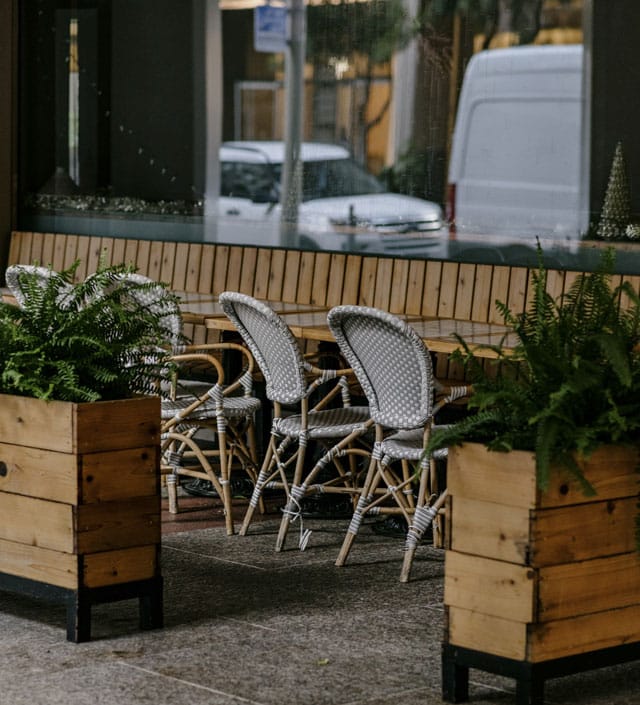So, you’re 20, 30, or even 40, and when you see the grab bars, slip-resistant tile and elevated toilets in your parents’ or grandparents’ house, you don’t really see them. That’s not your reality.
But it will be.
Ryan Frederick, an author, teacher, lecturer and blogger in his 40s, and a specialist in why certain places make people happy, knows that it’s never too early to seek housing designed with its inhabitants’ longevity in mind.
“I could go on a rant about this, because many urban and suburban apartments that are being built today focus on millennials’ needs,” said Frederick, the founder and CEO of Here, a national consulting firm and consumer content platform that specializes in the intersection of place and healthy longevity.
“The bathrooms are generally smaller and not suited for inter-generational needs,” he said. “As we get older, one of our biggest fears is of falling, and the greatest risk of that happening is in the bathroom. So, one of the simple things we can do is to include elements of design in apartments in general that meet older people’s needs.”
Author of “Right Place, Right Time: The Ultimate Guide to Choosing a Home for the Second Half of Life,” and a consultant to developers and businesses on building better for longevity, Frederick spoke at a recent Stanford University Longevity Book Club Conversation about different housing options for the growing market of older adults. Martha Deevy and Ken Stern of the Stanford Center on Longevity moderated the event
Function and form
“If we believe that people are living longer, then somewhere in their 30s they should think about wanting housing more viable, because they will be living longer. Less than 5% of housing stock comes with a certain amount of features that allow one to safely age in place,” said Frederick. “I am suggesting that as a society we are better off creating more options for people to thrive beyond what exists today.’’
He said improved designs with longevity in mind could include levers for door handles and raising outlet levels.
“I am in my late 40s, and when I kneel down to put something in the outlet, it’s not as easy to get up anymore,” he said. “At our home in Austin, we have steps up into our front entry but we also made an attractive path that leads to the house. We didn’t have to trade off attractiveness for utility.’’
A real eye-opener
About 10,000 Americans are turning 65 on a daily basis, and Frederick said they need a place to live in the second half of their life that will meet their emotional and physical needs. Often this means meeting the needs of a couple who may not share the same taste and interests.
Options such as continuing care retirement communities (CRRC), intergenerational housing, repurposing of cities’ real estate, shared housing and international design were discussed during the book-club conversation.
Frederick has some unexpected insight. While doing an internship as a graduate student at Stanford University, he moved into a senior housing community for a month to get firsthand knowledge about the needs of aging adults.
“It opened my eyes to see how place impacts us, in this case, in the senior living context. I’m so glad I did it,” he said, although he couldn’t talk his wife into joining him. “It inspired me to write the book and helped me understand how we are shaped by place, in a much more profound way than I thought.’’
Outside of moving to a community for older adults, Frederick said, finding the right place to live for the second half of life requires a strategy: Diligent research should be done on factors such as the makeup of neighborhoods (whether residents are predominantly young with growing families or a mixture of ages), housing design, transportation, proximity to medical care, entertainment and restaurants.
Other options
Older adults who want to stay put and age in place must be realistic, Frederick said.
“They may have been there for decades and they still want to know their neighbors, but they don’t know their neighbors any more. The social connection is so important but you probably have lost that in your own community.’’
How about home sharing?
“I still think it is a great idea because it’s creating more options. People have extra rooms that are underused or not utilized, and if you are sure you can get the right roommate, you have the benefit of revenue, but also, you have someone else in your life,” he said. “It could be some sort of friendship of a different dimension that is valuable to you, especially if you live alone.”
“It’s a version of ‘Golden Girls,’ circa 2023. I am particularly concerned about the loneliness and lack of social connection that our society struggles with. The more we can put ourselves into a place where we bump into people on a regular basis, the better.’’
On a recent trip to Europe, Frederick noted that shared housing has become more prevalent.
“I’m not aware of places (in the United States) that are aggressively creating meaningful incentives for shared housing. There are startups, such as WeLive, but they tend to be doing a bit more with younger people. There’s no reason why it couldn’t work with people who are older. I think it will continue to grow, so far as the growth is based purely on economics and seeing the benefits of shared square footage.’’
Finding middle ground
Frederick isn’t wildly optimistic about older adults building their dream home, unless money is no object.
“Housing costs are exceedingly high because of inflation. It’s expensive to buy land. We need to be concerned about the supply of housing coming our way: Will it be able to match the ongoing demand? That forces us to think creatively of ways to create additional supply.
“There is a need for allowing more middle-income housing — duplexes up to five-plexes. Here in Austin where I am, they are working to find ways to do middle housing,’’ he said.
Suburban shopping malls that suffered economic decline or closure from the 2008-2009 recession and the COVID-19 lockdown are potential sources of housing, Frederick said.
“Some of those malls are being redeveloped today to include medical offices and healthcare, and some are being used for housing. They could be used for senior living. But conversion from office to residential can be very complicated and expensive. It’s a case-by-case situation.’’
Home economics
Frederick said the demand for continuing care communities outstrips the supply, which drives up their cost. Inflation has contributed to rising costs, especially in coastal areas.
“If you move into a CCRC at 75 and you could live to 100, you need to work with a financial advisor to find out if you can afford the 25 more years,’’ he said. “We need to be concerned about the supply of housing coming our way: Will it be able to match the ongoing demand? That forces us to think creatively of ways to create additional supply.”
He encourages older adults to consider renting rather than owning their second-half-of-life home.
“We have created in our society to a fault a social status that tends to be coupled with being an owner. But the difference between quality of life is narrowing between ownership and rental,” Frederick said. Owners are more exposed to risk based on the housing market, and you may need to move and not be able to sell your house for the price you are looking for.
“And for a number of people who own their house outright, that capital can get a higher return in other places. So, I would encourage more people to take a serious look at whether they really need to own at this stage in life, versus renting.’’
Trading places
Then again, Frederick knows a couple, in their 60s, who sold their house and its furniture, moved to a condo in Austin in a neighborhood filled with young people, popular restaurants and plenty of entertainment. After a year, the luster had dimmed.
“So, they bought new furniture, sold their condo and bought a single- family house. They were fortunate they were able to afford it. Before you make a move, really think about it.’’
For older adults who want to stay in their single-family house, Frederick suggests renovating the house by putting a master bedroom and bath on the first floor.
Family affair
Frederick said he wrote the book with his parents in mind, as they entered the second half of life.
“Some books can be naïve. I did write this book in part for my parents because they don’t have a plan. They haven’t made as much headway as I would like, partly because they don’t agree on every part of this.”
He suggests couples share their needs and wishes about their new home, which he said, needn’t be the last stop. Perhaps a condo or townhome comes before a CCRC or senior community.
“It’s important to get all the facts out,” said Frederick. “Sometimes couples don’t know what their partner wants.’’
In a four-decade career in journalism, Eleanor O’Sullivan has reviewed many books on best practices for financial advisors, has written for Financial Advisor and the USA Today network, and was the movie critic for the Asbury Park Press.







